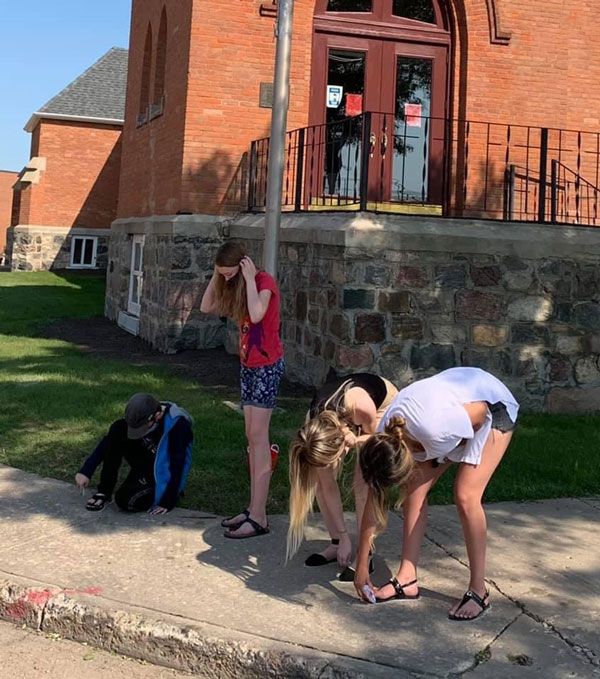
St. Alban’s Anglican Cathedral in Prince Albert is trying to do their part for reconciliation.
The church, which is located near Prince Albert’s downtown, have asked residents to outline their feet with chalk in support of residential school survivors and those children who didn’t return home.
St. Alban’s rector Father David Butorac said it was a way to recognize all of the people affected by the residential school system.
“It was, I think, a way to again make real what 215 (graves) looks like,” Butorac explained. “We used feet as a way of doing that. Feet just make the number 215 real, (and) by chalking out your own shoes it makes it more real. It’s a minor form of self identification with the kids lost.”
Butorac said that after the 215 unmarked graves were found in British Columbia, St. Albans tried to figure out the best way to recognize the loss. They talked with Indigenous church members to get a better sense of what they could do, and began creating the project.
“This idea was actually created by one of our congregation members Anne Barlow,” Buterac explained. “The whole idea (behind it) was ‘how do we process this? How do we recognize, just to observe it right, to do something?’”
Originally, the church left chalk beside the cathedral door for residents who wanted to participate. They’ve had a few stops and starts since then, as chalk goes missing, but they’ve kept the project going despite the setback.
Butorac said they’re still trying to find ways to make sure the chalk is available for everyone whenever they want to take part.
“We are still trying to figure out how to do it. It’s complicated in this neighbourhood,” Butorac said.
“A lot of people are comfortable with a lot of people around, and some people aren’t. It is a way for people to quietly come and do it on their own so that they have done something, and go their own way,” he added.
Butotrac said that the church membership is approximately 50 per cent First Nations and 50 per cent white settler and the board that operates the church is majority Metis.
“We have been doing this, living together, for a very long time and it is something that we are really proud of,” he said. “We don’t have to try. It has just been happening. Every year we renew our board and it just happens, it all works well and so we get to share how we both live and we try and build better understanding with each other.”
After the 215 graves were initially discovered, Butorac realized there would be more discoveries in the future. He chatted with congregation member Lawrence Joseph, who said that the church should keep these people on the church’s agenda.
“There is, I would say, real trauma being uncovered with my congregation members,” Butorac said. “They have shared things that they haven’t shared with anyone—the family taboo stuff.
Every family has skeletons in the closet. Well, for a lot of First Nations peoples, the skeletons are actually related to the residential schools and if there is one good thing to come out of this, it’s that these old wounds are, I think, finally being addressed.”
While the need for healing and support were major factors in the decision to start the project, Butorac said the desire for improved communication also played a role. He said it’s important to find meaningful ways to walk with survivors and all Indigenous people.
The concept began with posters that are on the Cathedral doors and expanded to the chalk feet outlines. The first poster displayed a prayer written by Indigenous Anglican Bishop Mark McDonald, with a statement from Cowesses Chief Cadmus Delorme underneath.
The second featured the names of students who died while at residential schools under the jurisdiction of the Anglican Diocese of Saskatchewan.
“It’s a quiet form of acknowledgement that these people have not been forgotten,” Butorac said. “These names were known, we have our archives downstairs and the archives of the Diocese of Saskatchewan participated with the Truth and Reconciliation Commission, so these names are in the TRC database.
“But instead of being on a database somewhere, we felt it was an appropriate time to write their names down. For dates where we have their date of death, we listed that. There is some kind of granule there that these are real people with real names and they died under our care,”
Butorac said each diocese serves as it’s own realm according to jurisdictional boundaries. The Anglican Church has an Indigenous bishop position, currently occupied by Adam Halkett.
Butorac said they’ve been at the forefront of working towards reconciliation for years and years, but acknowledged there are still challenges ahead.
“Everything we do is not enough, but we have to do something,” he said.
“I think we intentionally try and be agents of reconciliation,” he added. “We feel that as a church community of both First Nations and white settler people, that this something that we can and should do to promote healing. We try and do a little bit in our own way and this chalk is just one way to do it.”

